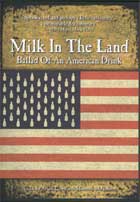
Milk in the Land: Ballad of an American Drink 2007
Distributed by Icarus Films, 32 Court St., 21st Floor, Brooklyn, NY 11201; 800-876-1710
Produced by Ariana Gerstein and Monteith McCollum
Directed by Ariana Gerstein and Monteith McCollum
DVD, color, 75 min.
Sr. High - Adult
Agriculture, Food, Economics, Nutrition
Date Entered: 01/07/2009
Reviewed by Janis Tyhurst, Reference Librarian, George Fox UniversityThis film presents information specifically on the milk industry. Starting with the beginnings of the milk industry, which came about from a need to do something with the grain used to make alcohol, to the arguments for and against raw milk, many interesting historical and social events in the evolution of milk in America are presented. The influence of politics on agricultural policy, specifically on the dairy industry, brings in archival film footage of Richard Nixon (praising milk as the American drink) and John F. Kennedy (toasting with a glass of milk). The U.S. government buys milk from farmers to keep the price of milk down and keep production up. It turns the excess milk into powdered milk that is stored across the U.S. in underground storage facilities at taxpayer expense.
After presenting the historical/social/political issues, the film takes a closer look at the agribusiness factory model of dairy farming vs. small farmer dairies, as well as the lesser known issues of seasonal vs. year round milking. Other issues that are addressed are the health effects of milk—does milk build strong bones or fill you up with artificial hormones, is it a good substitute for breast milk or does it create allergies, should the milk be pasteurized or raw. Interviews with dairy farmers, academics, physicians and food activists present the different viewpoints for and against these issues.
I like food history documentaries, but I struggled to make it through this one because of all the long slow panoramic scenes, the slow illumination of thoughts on a blackboard, and the annoying dissonant background music. It could be vastly improved if about 35 minutes of it were edited out. The many long panoramic views of cows in pastures or cutesy animated cutout advertisements for milk detract from the points being made. There is good information on this DVD if you are willing to skip through the excess scenery and put up with tonal dissonance, but you have to work for it.